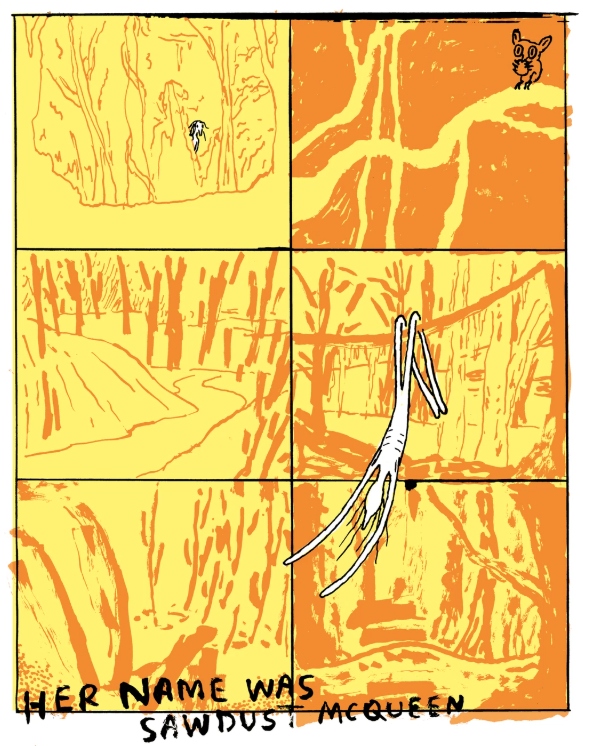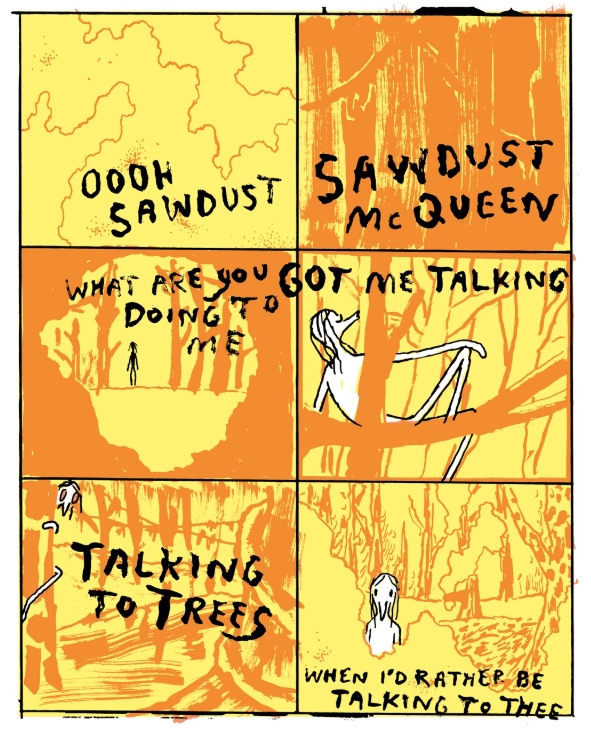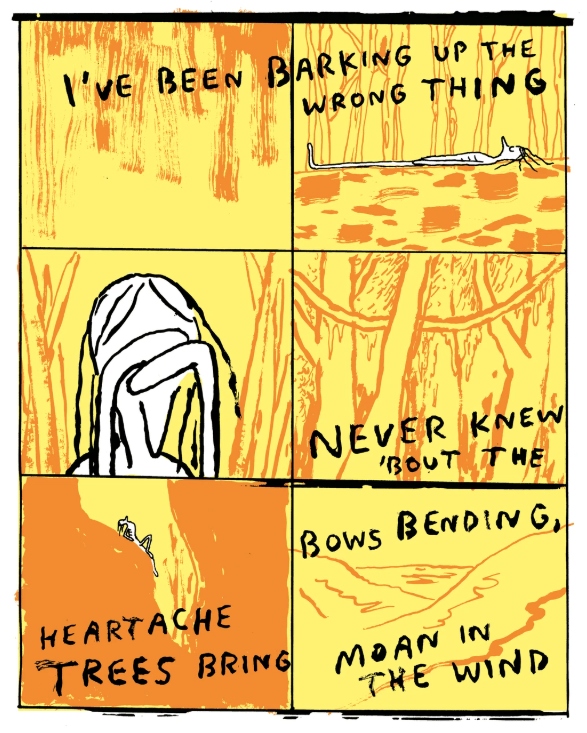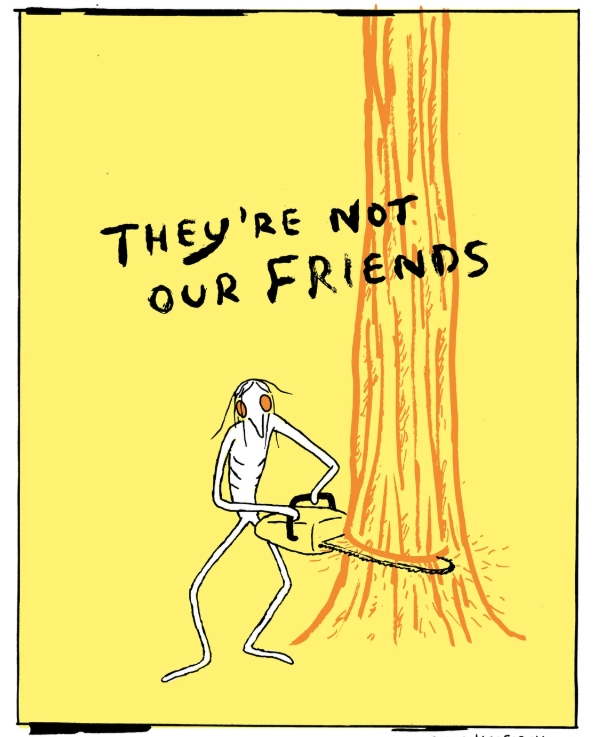Comics are not something that are normally “heard” in the traditional sense. Certainly, comics artists use their visual skills to convey noise, whether through emanata or lettering — my particular favorite is “KRAKA-DOOM”. So it’s always interesting when a comic has a soundtrack. It’s as if the artist feels compelled to add physical “sound” in order to complete their vision. This is the case with the final vignette in Anna Haifisch’s The Artist: The Circle of Life. In this comic, Haifisch directs the reader to sing along to the song Sawdust McQueen by the band Sorority while reading. You can listen to the song HERE. It’s a strange tune that provides some insight into how one could read the entirety of The Artist: The Circle of Life; by ending with this song, Haifisch completes her journey through her self-loathing spawned by her understanding of the pretentiousness of being “the artist”.

Sawdust McQueen starts with the sound of a chainsaw and the cry, “All clear, tree coming down!” From there it evolves into a slow groove, punctuated by the syrupy baritone of the singer discussing his relationship with the titular Sawdust McQueen who has “stepped out of a dream made by a machine” and who now has him talking to trees even though he’d rather be talking to her. The song is punctuated by the wail of a mournful guitar, and then the singer tells us that he’s “been barking up the wrong things” because he “never knew about the heartache trees bring.” Finally, he understands that while he “always thought that trees we’re our friends,” he’s come to realize that “they’re not our friends.” The song ends with the wailing guitar taking center stage, howling as the groove fades and the feedback amplifies.
Sorority, the band who performs Sawdust McQueen, are Elliott Batten, Max Batten, and Joe Kessler. Joe Kessler helps run the London-based publisher Breakdown Press (you can purchase a copy of Sorority’s album, Live at the Drive, from the Breakdown website). Breakdown Press is the publisher of The Artist: The Circle of Life. The circle is complete.

When the end of The Artist: The Circle of Life was first published on Vice, Haifisch thanked Sorority for writing “this fine song for The Artist”. In this thanks, it is unclear whether Haifisch is referring to “The Artist” as what comprises this book, or “The Artist” as her narrative stand-in that is the central figure of the book. But perhaps the antecedent doesn’t matter, because in the world of The Artist, the book and its creator are almost inseparable. Which then begs the questions, why choose this song, and why end the book with it?
The Artist is nigh on relentless in its attack on the travails of being a creator. Taken as an entirety, the book nearly drips with the choke-tears of its own “woe-is-me” as it explores the trope of the underappreciated sensitive artist floundering in a world more focused on accruing capital and status. The book vacillates wildly between the classic polarities of “these idiots don’t understand me” and “I’m the idiot for ever wanting this life” leading the reader to begin to distance themselves from the narrative stand-in in order not to avoid the back splatter of Haifisch’s pretentiousness and self-loathing. She swings the snooty privileged pathos of the relentlessness of her waffling egotism and egoism like a rubber mallet on the back of the reader’s head — trying to get their attention, trying to crack their skull. It’s exhausting.

And then, Sawdust McQueen.
Here, finally, at the end of The Artist: The Circle of Life, Haifisch confronts herself fully. She comes to the complete realization about what her longing for acceptance and the self-doubt that it engendered has done to her psyche. The trees are not her friend. It’s time to cut them down. The final image in the book is of the Artist staring directly at you, the reader, while cutting deep into the base of a huge tree, sawdust spitting from the chain saw.
And this moment needs the soundtrack, it demands that the wailing sonic feedbacked guitar is pulsating through your brain as you grok this image. There needs to be no mistake as to the intensity of the moment. She needs as many of your senses as she can engage in the moment to drive her point home. The act of destruction becomes an act of creation; Haifisch becomes akin to chainsaw-wielding Shiva dancing in the cosmos, destroying in order to renew. And she is doing so looking right at you.

Is this an accusatory stare or a power stance? Are you a tree, contributing to her previous cycle of pretentiousness and self-loathing, who needs to be cut down? Or will you be there, with her, another Sawdust McQueen, cutting down the trees and becoming something more than you were before?
Haifisch has stepped out of the circle and is clearing her own path. For what is an artist once they’ve detached themselves completely from that desire to be acknowledged and appreciated by the audience upon whom they fling themselves prostrate before? They become an original force of innovation. They become the self, enmeshed in the procreate urge. They become a gift to the universe.
Anna Haifisch’s The Artist: The Circle of Life is a book that must be endured in order to reach this moment. It requires the rhythmic groove, syrupy baritone, and wailing guitar of Sorority playing at full volume in your quarantine room in order to punctuate its redemptive arc. It is a book that confronts you to challenge yourself and then invites you to cut that shit down.
And dance.
SOLRAD is made possible by the generous donations of readers like you. Support our Patreon campaign, or make a tax-deductible donation to our publisher, Fieldmouse Press, today.

Leave a Reply